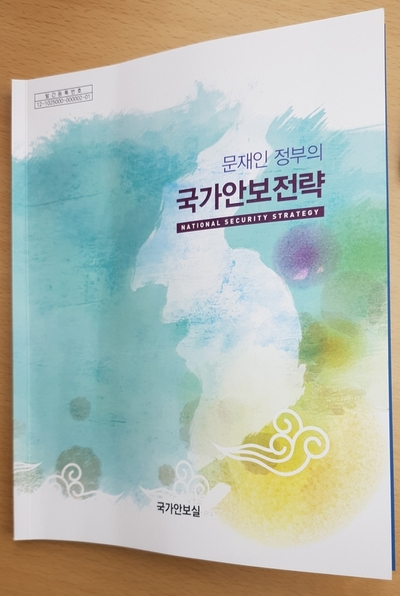Posted on : Dec.21,2018 16:14 KST
Modified on : Dec.21,2018 16:46 KST
 |
|
The national defense strategy of the Moon Jae-in administration
|
Strategy focuses on building peace with N. Korea and mediating role in NK-US negotiations
 |
|
The national defense strategy of the Moon Jae-in administration
|
On Dec. 20, the Blue House published the national security strategy of the Moon Jae-in administration, which is focused on South Korea playing a leading role in achieving denuclearization and peace on the Korean Peninsula with “a sense of ownership as a direct party to Korean Peninsula issues.” The Blue House also announced that it will be concluding a new basic agreement with North Korea in order to bring about the continuing development of inter-Korean relations.
The Blue House announced that its national security strategy has three goals: finding a peaceful solution to the North Korean nuclear issue and establishing permanent peace, contributing to the peace and prosperity of Northeast Asia and the world, and creating a secure society that protects the lives and safety of its people.
“The greatest challenge that our security faces today is the North Korean nuclear issue. In this process, we will continue to work for the peace and prosperity of the Korean Peninsula with a sense of ownership as a direct party to Korean Peninsula issues,” the Blue House said in its national security strategy.
“As we can infer from our experience with past negotiations, the process of denuclearization will not necessarily go smoothly. But since the inter-Korean and North Korea-US summits have made it clear that we are moving toward the establishment of permanent peace and the complete denuclearization of the Korean Peninsula, the government intends to be proactive and creative in its efforts to bring that about.”
“Based on close cooperation with the US, South Korea will play a leading role in bringing about denuclearization. Toward that end, we will continue to actively help North Korea and the US reach a compromise while steadily maintaining the momentum for dialogue,” the government stated in its national security strategy, indicating that it will continue to act as a facilitator and mediator in North Korea-US dialogue.
The Blue House said that it’s planning to conclude a new basic agreement with North Korea through future inter-Korean summits and high-level talks.
“The creation of an institutional foundation is critical for the steady and continuing development of inter-Korean relations. Toward that end, the government plans to carry out concrete deliberations in inter-Korean summits and high-level talks to conclude a new inter-Korean basic agreement that conforms to the altered circumstances and environment on a basis of respect for previous agreements. We will be exploring ways to secure support and build a consensus for the inter-Korean basic agreement when it’s concluded through the ratification of the National Assembly domestically and through a resolution of support at the UN internationally,” the government said in its national security strategy.
The national security strategy predicts that the resolution of the North Korean nuclear issue could pave the way for peace and prosperity on the Korean Peninsula: “Progress toward resolving the North Korean nuclear issue and the creation of the right conditions would lead to the full implementation of the new economic plan for the Korean Peninsula, creating a virtuous cycle of inter-Korean peace and prosperity. If this plan is realized, inter-Korean cooperation is expected to not only be a driver of new growth that would stimulate the domestic economy and create jobs but also a foundation for peaceful cooperation on the Korean Peninsula and in Northeast Asia.”
Absence of concepts framed by Park Geun-hye administration
This document does not include concepts that appeared in the national strategic guidelines framed by the Park Geun-hye administration in 2014 such as “establishing firm military readiness against North Korea” and “a strategy of responding militarily to the threat of North Korea’s weapons of mass destruction” through the “Kill Chain” or the Korean Air and Missile Defense System.
The national defense strategy outlines the government’s supreme guidelines for national security and contains policy directions that apply to foreign policy, unification and national defense. This kind of document has been drafted and released during each previous administration. The document that was released is intended for public consumption, while the detailed guidelines are a class-two secret. The government is planning to print 20,000 copies of the national defense strategy and to distribute these at government ministries, agencies, local government bodies and national and public libraries.
By Seong Yeon-cheol, staff reporter
Please direct comments or questions to [english@hani.co.kr]










